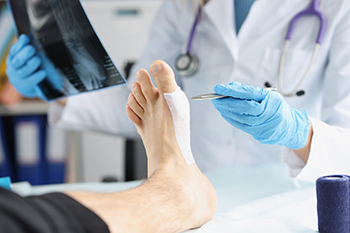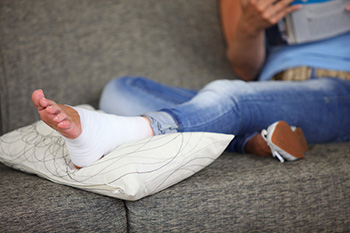Connect With Us
Blog
Items filtered by date: October 2023
Why the Shape of Your Feet Matters

Your feet are the foundation of your body, and when the shape of your foot is compromised, it can have far-reaching consequences. Wearing Ill-fitting shoes can worsen conditions such as bunions, hammertoes, and plantar fasciitis. They also may lead to biomechanical adjustments that can cause back and joint pain, balance problems, postural issues, and leg discomfort. Foot arches are of three main types, which are high, neutral, and flat. High arches are overly pronounced, causing pressure on the heel and forefoot, while flat feet may restrict mobility and lead to other health problems. In addition, pronation and supination, which refers to the side to side movement of the foot when you stand, walk or run, are factors that need to be considered when buying shoes. Supination involves the foot rolling outward, often affecting those with high arches, and potentially leading to lower leg discomfort like plantar fasciitis. Overpronation occurs when the foot rolls excessively inward, common in people with flat feet, and this can cause discomfort as well as alignment issues throughout the body. For help with issues involving the shape of your feet, it is suggested that you make an appointment with a podiatrist for an evaluation.
If you have any concerns about your feet, contact Jeffrey L. Bober, DPM from Maryland. Our doctor can provide the care you need to keep you pain-free and on your feet.
Biomechanics in Podiatry
Podiatric biomechanics is a particular sector of specialty podiatry with licensed practitioners who are trained to diagnose and treat conditions affecting the foot, ankle and lower leg. Biomechanics deals with the forces that act against the body, causing an interference with the biological structures. It focuses on the movement of the ankle, the foot and the forces that interact with them.
A History of Biomechanics
- Biomechanics dates back to the BC era in Egypt where evidence of professional foot care has been recorded.
- In 1974, biomechanics gained a higher profile from the studies of Merton Root, who claimed that by changing or controlling the forces between the ankle and the foot, corrections or conditions could be implemented to gain strength and coordination in the area.
Modern technological improvements are based on past theories and therapeutic processes that provide a better understanding of podiatric concepts for biomechanics. Computers can provide accurate information about the forces and patterns of the feet and lower legs.
Understanding biomechanics of the feet can help improve and eliminate pain, stopping further stress to the foot.
If you have any questions please feel free to contact our office located in Glen Burnie, MD . We offer the newest diagnostic and treatment technologies for all your foot and ankle needs.
A Painful Arthritic Condition Called Gout

Gout, often called the disease of kings, is a form of inflammatory arthritis that has plagued humanity for centuries. It is commonly caused by excess uric acid crystals in joints, primarily targeting the big toe. Uric acid is a natural byproduct of purine metabolism, but when levels become excessively high, crystals form and lead to intense pain, inflammation, and swelling in the affected joint. Gout attacks, also known as flares, can be sudden and excruciating. Various factors contribute to gout, including genetics, dietary choices, obesity, and other medical conditions. Lifestyle modifications, dietary changes, and medications are commonly employed to manage and prevent gout. Gout attacks can interrupt daily activities. If you have this painful condition, it is strongly suggested that you are under the care of a podiatrist who can help you to manage this ailment successfully.
Gout is a painful condition that can be treated. If you are seeking treatment, contact Jeffrey L. Bober, DPM from Maryland. Our doctor will treat your foot and ankle needs.
What Is Gout?
Gout is a form of arthritis that is characterized by sudden, severe attacks of pain, redness, and tenderness in the joints. The condition usually affects the joint at the base of the big toe. A gout attack can occur at any random time, such as the middle of the night while you are asleep.
Symptoms
- Intense Joint Pain - Usually around the large joint of your big toe, and it most severe within the first four to twelve hours
- Lingering Discomfort - Joint discomfort may last from a few days to a few weeks
- Inflammation and Redness -Affected joints may become swollen, tender, warm and red
- Limited Range of Motion - May experience a decrease in joint mobility
Risk Factors
- Genetics - If family members have gout, you’re more likely to have it
- Medications - Diuretic medications can raise uric acid levels
- Gender/Age - Gout is more common in men until the age of 60. It is believed that estrogen protects women until that point
- Diet - Eating red meat and shellfish increases your risk
- Alcohol - Having more than two alcoholic drinks per day increases your risk
- Obesity - Obese people are at a higher risk for gout
Prior to visiting your podiatrist to receive treatment for gout, there are a few things you should do beforehand. If you have gout you should write down your symptoms--including when they started and how often you experience them, important medical information you may have, and any questions you may have. Writing down these three things will help your podiatrist in assessing your specific situation so that he or she may provide the best route of treatment for you.
If you have any questions, please feel free to contact our office located in Glen Burnie, MD . We offer the newest diagnostic and treatment technologies for all your foot care needs.
Minimally Invasive Foot Surgery

Minimally invasive foot surgery, known as the keyhole approach, is an advanced method for addressing foot pain caused by abnormal anatomy. This technique utilizes specialized instruments for each condition, assisted by intraoperative imaging like X-rays and fluoroscopy. These tools allow surgeons to perform the surgery through small incisions, aiming to minimize damage to muscles and surrounding structures, possibly leading to faster recovery and reduced pain. Notably, minimally invasive foot surgery can often eliminate the need for pins and screws, which results in cost savings for patients and reduces the burden on healthcare systems while providing aesthetically pleasing results. The advantages of this type of surgery over traditional open foot surgery include smaller scars, reduced infection risk, and minimal blood loss. It also offers aesthetic benefits and allows immediate weight bearing. However, like any surgery, minimally invasive foot surgery carries risks, including infection, nerve injury, and potential complications related to general anesthesia. If you are suffering from chronic foot pain, it is suggested that you make an appointment with a podiatrist who can evaluate your case and see if you are a good candidate for this type of surgery.
Foot surgery is sometimes necessary to treat a foot ailment. To learn more, contact Jeffrey L. Bober, DPM of Maryland. Our doctor will assist you with all of your foot and ankle needs.
When Is Surgery Necessary?
Foot and ankle surgery is generally reserved for cases in which less invasive, conservative procedures have failed to alleviate the problem. Some of the cases in which surgery may be necessary include:
- Removing foot deformities like bunions and bone spurs
- Severe arthritis that has caused bone issues
- Cosmetic reconstruction
What Types of Surgery Are There?
The type of surgery you receive will depend on the nature of the problem you have. Some of the possible surgeries include:
- Bunionectomy for painful bunions
- Surgical fusion for realignment of bones
- Neuropathy decompression surgery to treat nerve damage
Benefits of Surgery
Although surgery is usually a last resort, it can provide more complete pain relief compared to non-surgical methods and may allow you to finally resume full activity.
Surgical techniques have also become increasingly sophisticated. Techniques like endoscopic surgery allow for smaller incisions and faster recovery times.
If you have any questions please feel free to contact our office located in Glen Burnie, MD . We offer the newest diagnostic and treatment technologies for all your foot and ankle needs.
Alternative Therapies for Non-Healing Diabetic Foot Ulcers

Maggot therapy, also known as Maggot Debridement Therapy, MDT, or Larval therapy, has a long history in medicine and has gained recent recognition for its unique ability to save limbs. This biotherapy involves placing disinfected maggots, often the larvae of the greenbottle blowfly, on wounds, such as diabetic foot ulcers, to debride necrotic tissues. It is particularly effective when antibiotics fail to combat bacterial infections in non-healing wounds, potentially preventing limb amputations. Maggots work by secreting special enzymes, which break down necrotic tissue, making it easier to digest and absorb. They also produce antibiotic-like agents and release ammonia to inhibit bacterial growth in the wound. Administration involves placing sterile maggots within a dressing on the wound for 48 to 72 hours. This therapy has broad applications, including diabetic ulcers, vascular ulcers, pressure ulcers, and even malignant wounds. Studies have shown that maggot therapy accelerates wound healing, reduces necrotic tissue, and decreases wound odor. While this therapy is highly effective, it should not be used for wounds near vital organs or blood vessels and in septic patients. Additional research can further expand the applications of this therapy, however, it saves 40 to 50 percent of limbs when used as a last resort. If you have a non-healing diabetic foot wound and would like alternative treatments for healing, it is suggested that you make an appointment with a podiatrist to discuss this further.
Wound care is an important part in dealing with diabetes. If you have diabetes and a foot wound or would like more information about wound care for diabetics, consult with Jeffrey L. Bober, DPM from Maryland. Our doctor will assess your condition and provide you with quality foot and ankle treatment.
What Is Wound Care?
Wound care is the practice of taking proper care of a wound. This can range from the smallest to the largest of wounds. While everyone can benefit from proper wound care, it is much more important for diabetics. Diabetics often suffer from poor blood circulation which causes wounds to heal much slower than they would in a non-diabetic.
What Is the Importance of Wound Care?
While it may not seem apparent with small ulcers on the foot, for diabetics, any size ulcer can become infected. Diabetics often also suffer from neuropathy, or nerve loss. This means they might not even feel when they have an ulcer on their foot. If the wound becomes severely infected, amputation may be necessary. Therefore, it is of the upmost importance to properly care for any and all foot wounds.
How to Care for Wounds
The best way to care for foot wounds is to prevent them. For diabetics, this means daily inspections of the feet for any signs of abnormalities or ulcers. It is also recommended to see a podiatrist several times a year for a foot inspection. If you do have an ulcer, run the wound under water to clear dirt from the wound; then apply antibiotic ointment to the wound and cover with a bandage. Bandages should be changed daily and keeping pressure off the wound is smart. It is advised to see a podiatrist, who can keep an eye on it.
If you have any questions, please feel free to contact our office located in Glen Burnie, MD . We offer the newest diagnostic and treatment technologies for all your foot care needs.
Types and Severity of Ankle Sprains

Ankle sprains are a common injury that can happen to anyone, from athletes to those simply walking down the street. Understanding the different types and severity of ankle sprains is necessary for proper diagnosis and treatment. Mild ankle sprains typically involve stretching or slight tearing of the ligaments. These sprains are characterized by minimal pain and swelling and usually recover with rest, ice, compression, and elevation. Moderate ankle sprains, on the other hand, result in more extensive ligament damage, leading to more pain, swelling, and difficulty bearing weight or walking. Treatment often requires immobilization of the ankle joint with a brace or cast and can take several weeks to heal. Severe ankle sprains represent a complete tear of one or more ligaments, causing extreme pain, swelling, and instability. Bearing weight is impossible. In such cases, treatment may involve surgery and a months-long recovery period. Prompt evaluation and appropriate care for ankle sprains are essential to prevent chronic sprains. If you suspect an ankle sprain, it's suggested that you make an appointment with a podiatrist for a full exam and appropriate treatment based on the severity of your injury.
Ankle sprains are common but need immediate attention. If you need your feet checked, contact Jeffrey L. Bober, DPM from Maryland. Our doctor can provide the care you need to keep you pain-free and on your feet.
How Does an Ankle Sprain Occur?
Ankle sprains take place when the ligaments in your ankle are torn or stretched beyond their limits. There are multiple ways that the ankle can become injured, including twisting or rolling over onto your ankle, putting undue stress on it, or causing trauma to the ankle itself.
What Are the Symptoms?
- Mild to moderate bruising
- Limited mobility
- Swelling
- Discoloration of the skin (depending on severity)
Preventing a Sprain
- Wearing appropriate shoes for the occasion
- Stretching before exercises and sports
- Knowing your limits
Treatment of a Sprain
Treatment of a sprain depends on the severity. Many times, people are told to rest and remain off their feet completely, while others are given an air cast. If the sprain is very severe, surgery may be required.
If you have suffered an ankle sprain previously, you may want to consider additional support such as a brace and regular exercises to strengthen the ankle.
If you have any questions please feel free to contact our office located in Glen Burnie, MD . We offer the newest diagnostic and treatment technologies for all your foot and ankle needs.
We Can Treat Your Foot or Ankle Pain
Blog Archives
- April 2025
- March 2025
- February 2025
- January 2025
- December 2024
- November 2024
- October 2024
- September 2024
- August 2024
- July 2024
- June 2024
- May 2024
- April 2024
- March 2024
- February 2024
- January 2024
- December 2023
- November 2023
- October 2023
- September 2023
- August 2023
- July 2023
- June 2023
- May 2023
- April 2023
- March 2023
- February 2023
- January 2023
- December 2022
- November 2022
- October 2022
- September 2022
- August 2022
- July 2022
- June 2022
- May 2022
- April 2022
- March 2022
- February 2022
- January 2022
- December 2021
- November 2021
- October 2021
- September 2021

